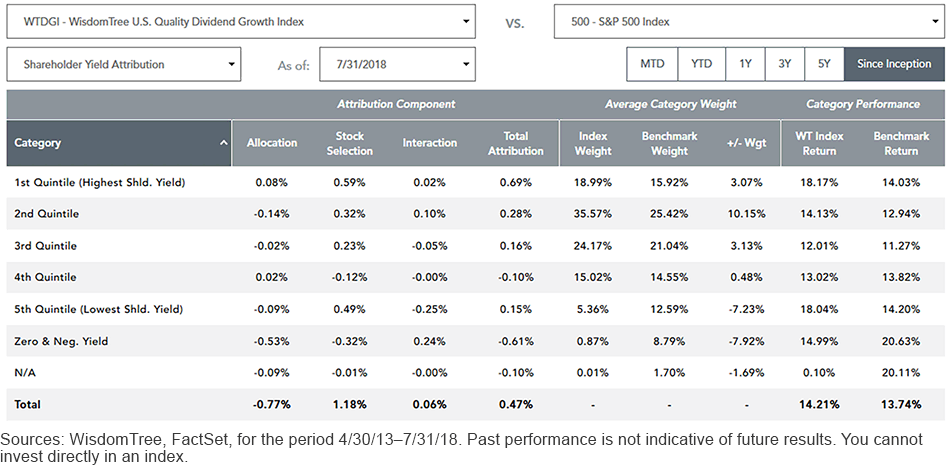Our Late-Cycle Investing Guide: Quality at Reasonable Multiples


Across the country, about one in five Americans1 is spending August reviewing fantasy football pre-draft guides to strategize the best bang for their buck by position: maybe some combination of proven quality players that won’t break the bank like veterans Drew Brees and Golden Tate, coupled with an upstart rookie like Saquon Barkley if still available midway through the first round. At WisdomTree, we’ve spent August trying to help investors form a game plan around a fundamental but critical question for their portfolios: What are your best ideas for investing at this later stage of the U.S. economic cycle?
Our answer: an approach that targets quality companies with strong balance sheets and healthy profitability at reasonable valuations.
My colleague’s blog post broke down the return patterns of factors leading up to and during downturns and concluded that quality was “the best of factors in the worst of times.” The behavioral rationale for this anomaly: when times get tough, investors become acutely focused on differences in current profitability and less attracted to promises of future revenue growth.
Five years ago, WisdomTree launched a global family of Quality Dividend Growth Indexes that has yielded impressive real-time results. A characteristic of these Indexes across global equity markets is the valuation premiums quality investing commands, with the U.S. the cheapest by our preferred measures.
Quality on Sale in the U.S?
The key to a successful fantasy football draft is to get the best performance from a player relative to the price paid. This concept, looking for quality at reasonable prices, is the same logic we take when we approach quality investing.
Warren Buffett’s feelings on combining the elements of quality and value into one investing approach is summed up by the following quotation: “Value is buying good companies at cheap prices. Quality is buying great companies at fair prices."2
WisdomTree’s Quality Dividend Growth Indexes, those for the U.S. as well as developed and emerging markets, select for quality dividend-paying companies based on three criteria: return on equity, return on assets and earnings growth expectations. After this quality screen, constituents are then weighted based on dividends.
The key to this approach, and all of WisdomTree’s fundamentally weighted Indexes, is to delink price from constituent weights in order to mitigate paying premium prices for stocks simply because market prices dictate owning more of an increasingly expensive stock.
In the table below we show estimated price-to-earnings ratios and shareholder yields for the WisdomTree U.S. Quality Dividend Growth Index as well as the WisdomTree U.S. High Dividend Index in each respective region to illustrate the resulting valuations from this screening and weighting process across markets.

High Yield vs. Quality
The WisdomTree High Dividend Index, constituted with the highest-dividend-yielding companies in each market, represents a deeper value cut of each respective market. What is interesting to note is that in the developed and emerging markets, the quality Indexes are 44% and 66% more expensive, measured by P/E ratios, than the high-dividend Indexes. In the U.S., this premium is a much more modest 5.8%.
On the basis of shareholder yield, a measure combining dividend yield and net buyback yield, the high-dividend Indexes in the developed international and emerging markets have a 1.68% and 2.25% yield advantage to the respective quality Index. In the U.S., the shareholder yield of the quality Index is roughly equivalent to the high-dividend Index.
Thus, in the U.S., the dividend yield that is sacrificed when comparing the quality Index to the high-dividend Index is more than made up for in the net buyback yield benefit for the quality Index. The process of screening for profitable, growing companies results in constituents that are not only growing their dividends but are also buying back more shares. How has increased weight in companies with higher shareholder yields contributed to returns?
Reviewing the Box Score: Higher Shareholder Yields Boost Outperformance
Using the attribution tool available on our website, we are able to quantify the impact on relative returns for the WisdomTree U.S. Quality Dividend Growth Index across shareholder yield quintiles. Since inception, one of the more interesting things to note is the best-performing segment in the S&P 500 is that of companies with zero or negative shareholder yield. This category returned 20.6%, far and away the best-performing category in the benchmark. This is not surprising when one considers that the type of companies that have outperformed have been information technology and consumer discretionary companies that are neither paying dividends nor are net purchasers of their own shares. The WisdomTree Index was under-weight in this segment of the market by nearly 8%, resulting in a headwind to the strategy of 61 basis points (bps).

In the face of this headwind, the WisdomTree Index’s combined over-weight of more than 13% in the top two yielding quintiles offered up nearly 100 bps of outperformance, contributing to the Index outperforming the S&P 500 by 47 bps. What this tells us is that over a long enough period, in this case just over five years, a broad approach that assigns greater weight to companies consistently rewarding their shareholders via dividends and share buybacks can result in superior aggregate total returns—even amid a sustained rally from non-dividend-paying companies.
With the First-Round Pick…
The table below helps summarize select relevant fundamentals to illustrate how WisdomTree’s Index compares to respective MSCI quality and value indexes, as well as the broader market. In sum, the WisdomTree Index stacks up between the quality and value Indexes on measures of valuation (P/E and Dividend Yield) and profitability (ROE and ROA), and bests the S&P 500 on both.
Given the well-documented benefits of owning quality companies with an eye to valuation discipline, we would rank the WisdomTree U.S. Quality Dividend Growth highly on our draft board.

1Eric Allen Hall, “The Dark Side of Fantasy Football,” The Washington Post, 9/10/17.
2Robert Novy-Marx, “Quality Investing,” University of Rochester, December 2012 (significantly revised May 2014).


